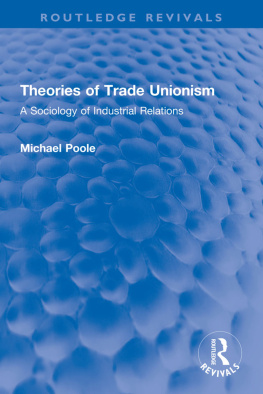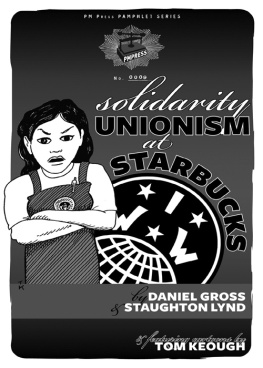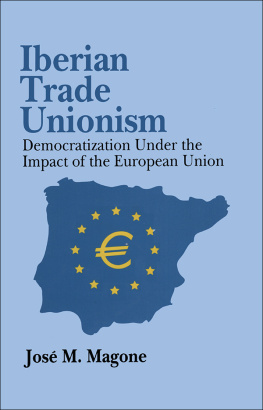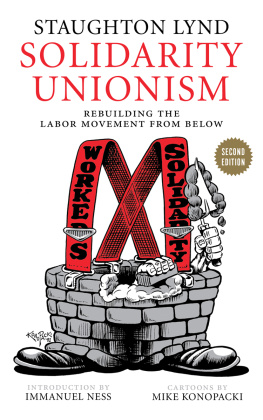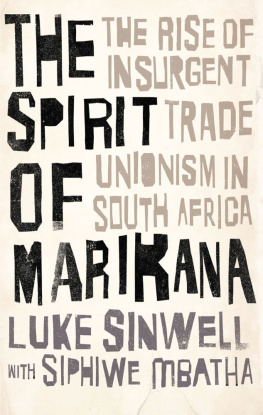Hyman Richard - Understanding European Trade Unionism
Here you can read online Hyman Richard - Understanding European Trade Unionism full text of the book (entire story) in english for free. Download pdf and epub, get meaning, cover and reviews about this ebook. year: 2001, publisher: SAGE Publications, genre: Politics. Description of the work, (preface) as well as reviews are available. Best literature library LitArk.com created for fans of good reading and offers a wide selection of genres:
Romance novel
Science fiction
Adventure
Detective
Science
History
Home and family
Prose
Art
Politics
Computer
Non-fiction
Religion
Business
Children
Humor
Choose a favorite category and find really read worthwhile books. Enjoy immersion in the world of imagination, feel the emotions of the characters or learn something new for yourself, make an fascinating discovery.

- Book:Understanding European Trade Unionism
- Author:
- Publisher:SAGE Publications
- Genre:
- Year:2001
- Rating:4 / 5
- Favourites:Add to favourites
- Your mark:
- 80
- 1
- 2
- 3
- 4
- 5
Understanding European Trade Unionism: summary, description and annotation
We offer to read an annotation, description, summary or preface (depends on what the author of the book "Understanding European Trade Unionism" wrote himself). If you haven't found the necessary information about the book — write in the comments, we will try to find it.
Understanding European Trade Unionism — read online for free the complete book (whole text) full work
Below is the text of the book, divided by pages. System saving the place of the last page read, allows you to conveniently read the book "Understanding European Trade Unionism" online for free, without having to search again every time where you left off. Put a bookmark, and you can go to the page where you finished reading at any time.
Font size:
Interval:
Bookmark:
A Stylized Introduction
In the Nordic countries, trade unions and employers organizations are usually described as the labour market parties. In Britain, it has been traditional to speak of the two sides in industrial relations. In many other European countries, the normal term is the social partners. These differences in vocabulary neatly encapsulate a core concern of this book. In different national contexts and historical periods, trade unions may be seen by their own members and officials and by outsiders primarily as economic agencies engaged in collective bargaining over routine terms and conditions of employment; as fighting organizations confronting employers in a struggle between hostile classes; or as components of the fabric of social order. In some times and places, they may be perceived in all these guises simultaneously.
Trade unions in twentieth-century Europe have displayed a multiplicity of organizational forms and ideological orientations. The pluralism of trade unionisms (Dufour, 1992) is associated with conflicting definitions of the very nature of a union, rival conceptions of the purpose of collective organization, opposing models of strategy and tactics. The dominant identities embraced by particular unions, confederations and national movements themselves reflecting the specific contexts in which national organizations historically emerged (Crouch, 1993) have shaped the interests with which they identify, the conceptions of democracy influencing members, activists and leaders, the agenda they pursue, and the type of power resources which they cultivate and apply. The clash between distinctive ideological visions of trade union identity has led in almost every European country to the fragmentation of labour movements.
To simplify the analysis of this complex diversity I identify three ideal types of European trade unionism, each associated with a distinctive ideological orientation. In the first, unions are interest organizations with predominantly labour market functions; in the second, vehicles for raising workers status in society more generally and hence advancing social justice; in the third, schools of war in a struggle between labour and capital (Hyman, 1994 and 1995).
Trade unions as substantial organizations were products of the industrial revolution, even though in some countries they evolved with no significant disjuncture from pre-capitalist artisanal associations. Indeed the very word trade union (which is not translated literally in most European languages) denotes a combination of workers with a common craft or skill. Initially their character and orientations reflected the circumstances of their formation: in most of Europe, brutal resistance by employers to assertions of independence and opposition on the part of the workforce, often accompanied by state repression. Such hostility in turn encouraged in trade unions militant, oppositional, sometimes explicitly anti-capitalist dispositions towards employers; and radical political attitudes which in circumstances of restricted franchise and autocratic government were not clearly distinguishable from revolutionary socialism. This, not surprisingly, reinforced the antagonism of unions opponents.
Yet trade unions survived repression; over decades, indeed generations, survival encouraged and was in turn supported by some form of accommodation. Its features varied between (and often within) countries; but typically the latter half of the nineteenth century saw the more successful unions marginalizing or ritualizing their radicalism, and seeking understandings with employers on the basis of the maxim of a fair days wage for a fair days work a principle whose concrete meaning, Marx complained, was determined by the operation of the (bourgeois) laws of supply and demand.
The clearest instance of this de-radicalization was in Britain, and underlay the Webbs classic definition of a trade union: a continuous association of wage-earners for the purpose of maintaining or improving the conditions of their employment (1894: 1). Lenin, as is well known, was greatly influenced by the analysis of the Webbs when constructing his 1902 polemic What is To Be Done? Left to develop spontaneously, he argued, unions would become preoccupied with the defence of their members immediate occupational interests. The tendency towards pure-and-simple unionism (Nur-Gewerkschaftlerei) an accommodative and typically sectional economism could be resisted only through the deliberate intervention of a revolutionary party.
The debates of a century ago became associated with the triple polarization of trade union identities. One model sought to develop unionism as a form of anti-capitalist opposition. This was the goal of a succession of movements of the left: radical social democracy, syndicalism, communism. Despite substantial differences of emphasis and often bitter internecine conflicts the common theme of all variants of this model was a priority for militancy and socio-political mobilization. The mission of trade unionism, in this configuration, was to advance class interests.
A second model evolved in part as a rival to the first, in part as a mutation from it: trade unionism as a vehicle for social integration. Its first systematic articulation was at the end of the nineteenth century as an expression of social catholicism, which counterposed a functionalist and organicist vision of society to the socialist conception of class antagonism. On this ideological basis emerged in many countries a division between socialist-oriented unions and anti-socialist confessional rivals. Ironically, however, social-democratic unionism typically assumed many of the orientations of the latter, as social democracy itself shifted explicitly or implicitly from the goal of revolutionary transformation to that of evolutionary reform. Already in 1897 the Webbs (who were Fabian socialists) had called for unions to become agencies for the gradual democratization of industry; and across Europe, such a programme was increasingly attractive to union leaders who still proclaimed their socialist credentials but were anxious to legitimate their differences from critics on the left. Concurrently, many christian unionists adopted perspectives which were critical of capitalism, arguing that industry ... should have as its aim not private profit, but social needs (Lorwin, 1929: 587). Despite their organizational confrontation, then, social-democratic and christian-democratic unionisms came to share significant common ideological attributes: a priority for gradual improvement in social welfare and social cohesion, and hence a self-image as representatives of social interests.
A third model, not always clearly demarcated in practice from the second partly because its ideological foundations have more often been implicit than explicit is business unionism. Most forcefully articulated in the USA, but with variants in most English-speaking countries, this may be viewed as the self-conscious pursuit of economism. Its central theme is the priority of collective bargaining. Trade unions are primarily organizations for the representation of occupational interests, a function which is subverted if their operation is subordinated to broader socio-political projects: hence they must eschew political entanglements. The clearest articulation of a business union ideology is in Perlmans Theory of the Labor Movement (1928), where he condemned the interventions of both revolutionary and reformist socialists as obstacles to the maturity of a trade union mentality founded upon workers need for collective control of employment opportunities. Analogous arguments can be found, however, in the efforts of many continental European trade unions to assert their autonomy from the socialist parties which had engendered them; or in the sometimes tense relationship between British unions and the Labour Party, in which a strict demarcation between politics and industrial relations was often jealously asserted on both sides of the divide. The British notion of free collective bargaining and the German concept of
Font size:
Interval:
Bookmark:
Similar books «Understanding European Trade Unionism»
Look at similar books to Understanding European Trade Unionism. We have selected literature similar in name and meaning in the hope of providing readers with more options to find new, interesting, not yet read works.
Discussion, reviews of the book Understanding European Trade Unionism and just readers' own opinions. Leave your comments, write what you think about the work, its meaning or the main characters. Specify what exactly you liked and what you didn't like, and why you think so.


